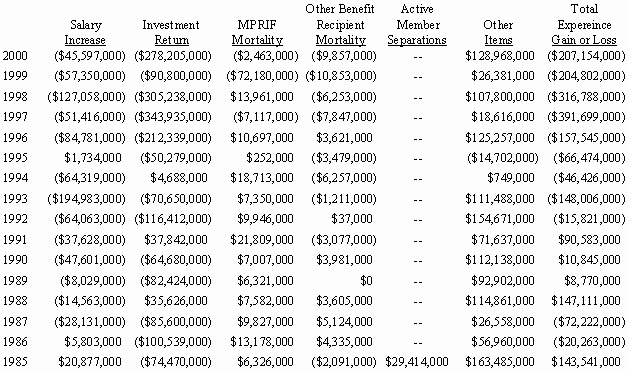- In General. Under Minnesota Statutes, Section 356.215, Subdivision 5, every four years, an experience study is required to be performed by the consulting actuary retained by the Commission for the General State Employees Retirement Plan of the Minnesota State Retirement System (MSRS-General), the General Employee Retirement Plan of the Public Employees Retirement Association (PERA-General), and the Teachers Retirement Association (TRA).
The quadrennial experience study compares the actual experience of the pension plan for that five-year period with the expected experience for the same period under the actuarial assumptions then applicable for the pension plan. The quadrennial experience study is intended, along with the actuarial gain and loss assessment portion of the annual actuarial valuation, to identify the need for actuarial assumption revisions.
Once a series of the actuarial gain and loss assessments of the annual actuarial valuations and one or more quadrennial experience studies indicate that an actuarial assumption has become an unreliable predictor of future occurrences, the process of developing a more reliable actuarial assumption and implementing a new actuarial assumption is initiated.
Because the actuarial services rendered to the Commission and the various public pension plans are provided by a combination of sources, chiefly the consulting actuary retained by the Legislative Commission on Pensions and Retirement and the consulting actuary retained as actuarial advisor by the applicable public pension plan, the task of the development of new actuarial assumptions can be performed by either consulting actuary or in combination. If there is a difference of opinion between these actuaries, professionally or personally, the development of new actuarial assumptions can be delayed or totally derailed.
Once revised actuarial assumptions are developed by an actuary, the revisions must be implemented. Minnesota Statutes, Section 356.215, Subdivision 4d, specifies the major economic actuarial assumptions, namely the interest (future investment performance) assumption, the salary growth (individual member) assumption, and the total payroll growth (total plan membership) assumption. Minnesota Statutes, Section 356.215, Subdivision 4e, requires the use of demographic and other economic actuarial assumptions that are consistent with the most recent quadrennial experience study (or the best estimate of future occurrences if no experience study for the applicable pension plan is required) and Minnesota Statutes, Section 356.215, Subdivision 7, requires the approval of nonstatutory actuarial assumptions by the Legislative Commission on Pensions and Retirement. - Annual PERA Experience Gain and Loss Assessments 1985-2000 . The annual actuarial valuations are required to contain an exhibit that attempts to allocate the sources of increases and decreases in the unfunded actuarial accrued liability of the pension plan. Four experience gain or loss items (five before 1986) are required to be assessed in the actuarial valuation, which are salary increase, investment return, retiree (Minnesota Post Retirement Investment Fund) mortality, and other benefit recipient (non-MPRIF) mortality. Other gains or losses are not required to be separately identified, although the Standards For Actuarial Work prescribed by the Commission require that additional analysis should be performed if the undesignated "other" items of unfunded actuarial accrued liability change is greater than two percent of the actuarial accrued liability or exceeds $50 million.
- 1996 PERA Experience Study Results and 2000 Assumption Changes . The 1996 PERA experience study covered the period June 30, 1992 to June 30, 1996, and was reported to the Commission on May 29, 1997.
The following sets forth the annual actuarial gain and loss identification for PERA for the past 16 years (since the actuary retained by the Commission has performed the regular annual actuarial valuation):
|
|
Note: $123,456,000 indicates an actuarial loss
($987,654,000) indicates an actuarial gain
The period 1985-2000, as assessed by the annual actuarial valuation gain and loss analysis, reflects significant salary gains (gains in 13 of the 16 years, averaging almost $65 million per year of gain), very significant investment gains (gains in 13 of the 16 years, averaging over $135 million per year of gain), modest retiree mortality losses (losses in 13 of the 16 years, averaging $10 million per year of loss), mixed gains and losses in other benefit recipient mortality (gains in 9 years and losses in 7 years), and relatively significant "other" losses (losses in 15 of 16 years, averaging over $85 million per year of loss).
The following summarizes the results of the 1996 PERA-General experience study and the recommendations of the actuary retained by the Commission:
